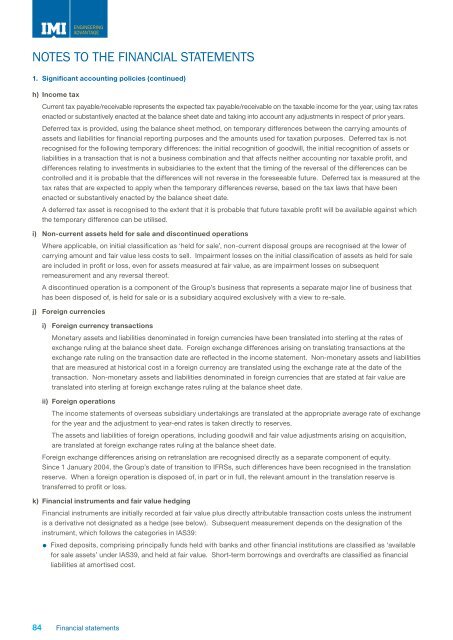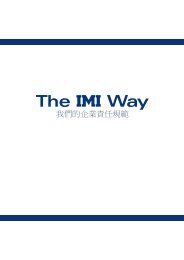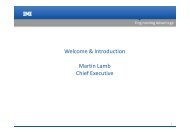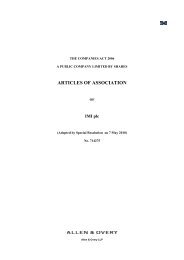IMI plc annual report 2012
IMI plc annual report 2012
IMI plc annual report 2012
You also want an ePaper? Increase the reach of your titles
YUMPU automatically turns print PDFs into web optimized ePapers that Google loves.
ENGINEERINGADVANTAGENotes to the Financial Statements1. Significant accounting policies (continued)h) Income taxCurrent tax payable/receivable represents the expected tax payable/receivable on the taxable income for the year, using tax ratesenacted or substantively enacted at the balance sheet date and taking into account any adjustments in respect of prior years.Deferred tax is provided, using the balance sheet method, on temporary differences between the carrying amounts ofassets and liabilities for financial <strong>report</strong>ing purposes and the amounts used for taxation purposes. Deferred tax is notrecognised for the following temporary differences: the initial recognition of goodwill, the initial recognition of assets orliabilities in a transaction that is not a business combination and that affects neither accounting nor taxable profit, anddifferences relating to investments in subsidiaries to the extent that the timing of the reversal of the differences can becontrolled and it is probable that the differences will not reverse in the foreseeable future. Deferred tax is measured at thetax rates that are expected to apply when the temporary differences reverse, based on the tax laws that have beenenacted or substantively enacted by the balance sheet date.A deferred tax asset is recognised to the extent that it is probable that future taxable profit will be available against whichthe temporary difference can be utilised.i) Non-current assets held for sale and discontinued operationsWhere applicable, on initial classification as ‘held for sale’, non-current disposal groups are recognised at the lower ofcarrying amount and fair value less costs to sell. Impairment losses on the initial classification of assets as held for saleare included in profit or loss, even for assets measured at fair value, as are impairment losses on subsequentremeasurement and any reversal thereof.A discontinued operation is a component of the Group’s business that represents a separate major line of business thathas been disposed of, is held for sale or is a subsidiary acquired exclusively with a view to re-sale.j) Foreign currenciesi) Foreign currency transactionsMonetary assets and liabilities denominated in foreign currencies have been translated into sterling at the rates ofexchange ruling at the balance sheet date. Foreign exchange differences arising on translating transactions at theexchange rate ruling on the transaction date are reflected in the income statement. Non-monetary assets and liabilitiesthat are measured at historical cost in a foreign currency are translated using the exchange rate at the date of thetransaction. Non-monetary assets and liabilities denominated in foreign currencies that are stated at fair value aretranslated into sterling at foreign exchange rates ruling at the balance sheet date.ii) Foreign operationsThe income statements of overseas subsidiary undertakings are translated at the appropriate average rate of exchangefor the year and the adjustment to year-end rates is taken directly to reserves.The assets and liabilities of foreign operations, including goodwill and fair value adjustments arising on acquisition,are translated at foreign exchange rates ruling at the balance sheet date.Foreign exchange differences arising on retranslation are recognised directly as a separate component of equity.Since 1 January 2004, the Group’s date of transition to IFRSs, such differences have been recognised in the translationreserve. When a foreign operation is disposed of, in part or in full, the relevant amount in the translation reserve istransferred to profit or loss.k) Financial instruments and fair value hedgingFinancial instruments are initially recorded at fair value plus directly attributable transaction costs unless the instrumentis a derivative not designated as a hedge (see below). Subsequent measurement depends on the designation of theinstrument, which follows the categories in IAS39:• Fixed deposits, comprising principally funds held with banks and other financial institutions are classified as ‘availablefor sale assets’ under IAS39, and held at fair value. Short-term borrowings and overdrafts are classified as financialliabilities at amortised cost.84 Financial statements
















